5V0-41.20 Online Practice Questions and Answers
Questions 4
Scenario 3: After resolving numerous connectivity issues throughout the various branch sites, connectivity between applications and users is finally present. The network administrator is informed that during certain tests, applications are not performing as they are expected to. Users report that call quality has not fully improved and that some of their calls either drop or have poor voice quality where the conversation is breaking up. Other users are noticing that file transfers are slower than expect. A group of users from a few sites have reported slowness in accessing internal and external applications.
Users at multiple branches complain that a highly performant SQL Database cluster residing at the New York Data Center is not responding to database queries or inserts as expected. It is affecting the order management site. A network administrator investigates and finds that traffic from the branches are going through Seattle to reach the SQL Cluster in New York. The design for this SD-WAN network does not call for routing security.
The SQL Cluster is reachable through either Data Center, but for performance reasons, must flow through the New York DC. The network administrator has verified that the routes are not present in the OFC and the BGP neighborship is down in Network Services.
Refer to the Exhibit(s).
Exhibit.
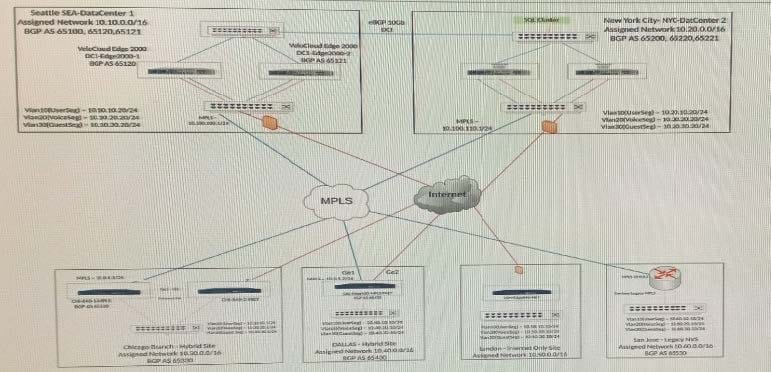
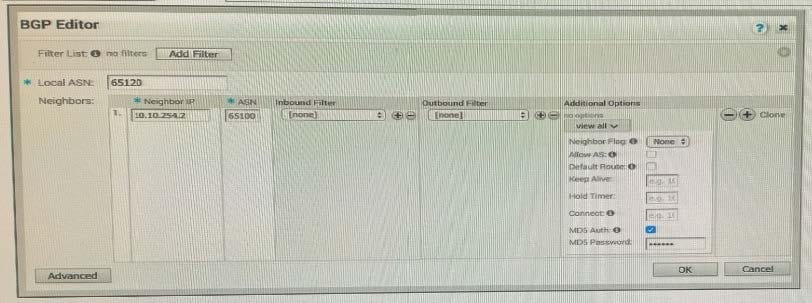
What should the administrator verify?
A. The BGP configuration has a filter in place to deny the prefix in New York.
B. The BGP Authentication matches on both sides.
C. The BGP configuration has a filter in place to deny the prefix in Seattle.
D. Backhauling through the Seattle DC is disabled.
Questions 5
Scenario 3:
After resolving numerous connectivity issues throughout the various branch sites, connectivity between applications and users is finally present. The network administrator is informed that during certain tests, applications are not performing as they are expected to. Users report that call quality has not fully improved and that some of their calls either drop or have poor voice quality where the conversation is breaking up. Other users are noticing that file transfers are slower than expect. A group of users from a few sites have reported slowness in accessing internal and external applications.
Exhibit.
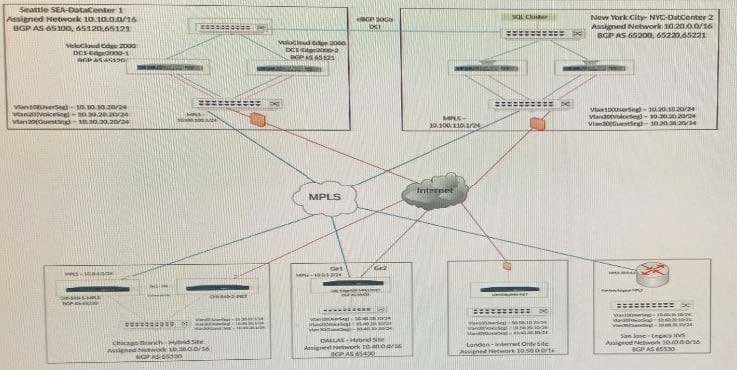
A network administrator wants to achieve better high-availability and network reconvergence between LAN-side BGP Networks and the hub Edges in New York.
What must the administrator do?
A. Modify the Keep Alive and Hold timers to the lowest possible values ensuring the Hold timer is 3 times more than the Keep Alive timer.
B. Nothing, the system will auto-rebalance connections and will provide sub-second convergence.
C. Modify the Connect and Hold timers to the lowest possible values ensuring the Hold timer is 3 times more than the Connect timer.
D. Modify the Keep Alive and Hold timers to the lowest possible values ensuring the Keep Alive timer is 3 times more than the Hold timer.
Questions 6
Scenario 2:
After completing the branch activation activities for all required branches, the network administrator attempts to test connectivity between the various branches and between the hubs and branches. The administrator notices a lack of connectivity despite being certain that configurations have been complete. The administrator also observed that several users are reporting intermittent connectivity to some of the applications they are accessing. Other users are reporting no access to these applications. Other users at some of the branches claim they cannot get to certain public resources. The administrator wants to ensure that all sites can talk to each other and all resources are accessible.
Exhibit.

Users at the London site are complaining of various intermittent issues around websites not loading, or applications being remotely accessed disconnecting sporadically and reconnecting after a few minutes. The network administrator does not see anything strange on the Edge overview page and decides to check if the CPU or memory have been hitting close to 100?
Where should the administrator verify this information?
A. In the VCO > Test 8c Troubleshoot > Remote Diagnostics > System Status
B. In the VCO > Monitor > Click London_Site01 > Click the System Tab
C. In the VCO > Remote Troubleshooting > Remote Actions > System Status
D. In the VCO > Monitor > Alerts
Questions 7
Scenario 3:
After resolving numerous connectivity issues throughout the various branch sites, connectivity between applications and users is finally present. The network administrator is informed that during certain tests, applications are not performing as they are expected to. Users report that call quality has not fully improved and that some of their calls either drop or have poor voice quality where the conversation is breaking up. Other users are noticing that file transfers are slower than expect. A group of users from a few sites have reported slowness in accessing internal and external applications.
Exhibit.
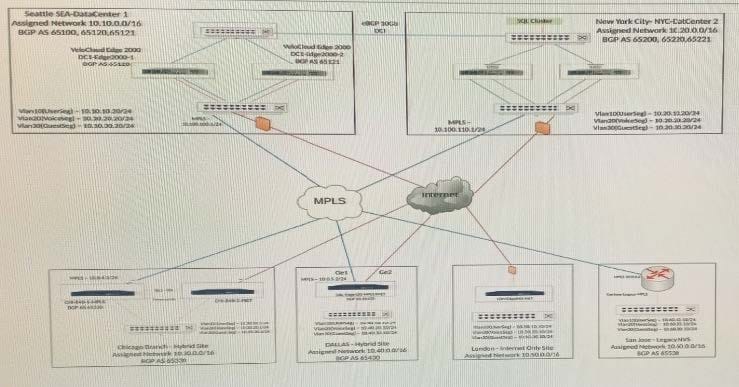
Users at the Dallas Branch are complaining that downloads/uploads from Office365 are slow. Working in Teams has been providing slow responses. The Internet circuit is 100Mbps while the MPLS Circuit is 45Mbps. Upon troubleshooting, the network administrator has noticed the traffic is Backhauling through the Seattle hub for all internet traffic.
How should the network administrator resolve the issue?
A. Leave the system as is, the gateways will resolve the issues after doing 15 minutes of link qualification.
B. Advertise public routes to Office365 and Teams through the New York Hub.
C. Leave the system as is, the hubs will auto-rebalance tunnels after doing 15 minutes of link qualification.
D. Prevent the hub from advertising a default route.
Questions 8
Scenario 1:
The Dallas Branch location is having issues getting activated. The local network administrator is aware that the Edge device received a DHCP address and was able to connect to the internet. The Orchestrator is reporting the Edge as Down. No other changes were made post activation.
A network administrator is tasked with enabling SD-WAN at three branch locations. A topology has been provided for reference. For each site, the administrator is having issues bringing edges
online, as another administrator has gone ahead and created a configuration ahead of time. The organization has several branch sites. One is am Internet-only site and two are Hybrid locations with both internet and MPLS. The last location is MPLS only. There are hub data center locations in this environment as well. Please refer to the topology.
Refer to the Exhibit(s).
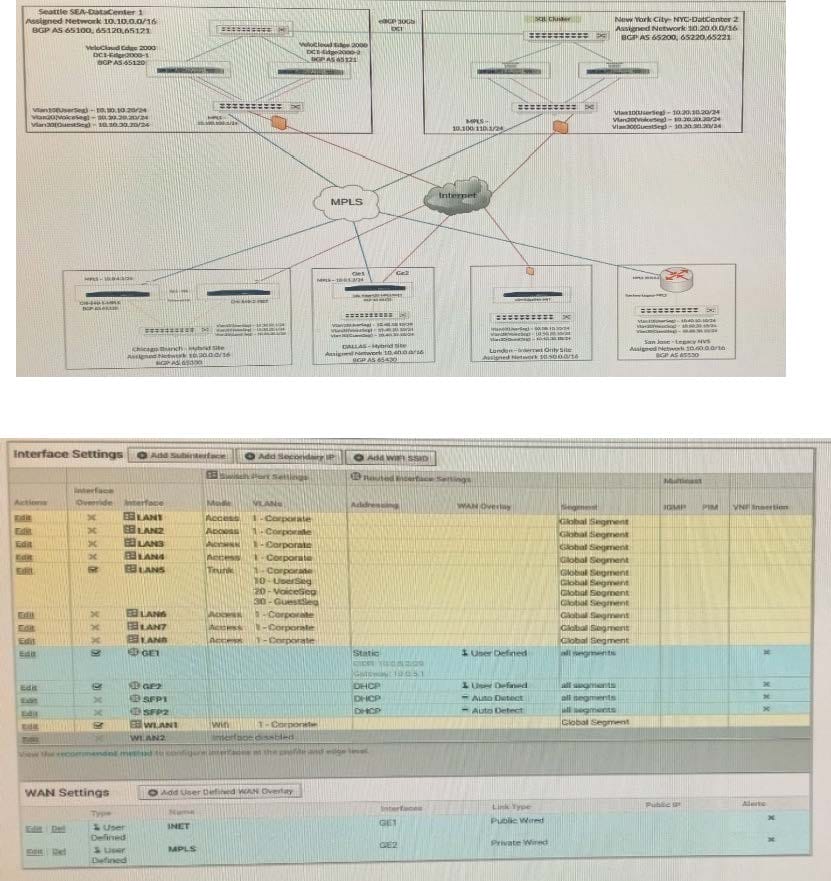
What is the cause of this issue?
A. The activation link did not specify the updated image location requiring the Edge to be re-activated.
B. The activation link did not contain any post-activation configuration to allow the Orchestrator to communicate with the Edge.
C. The Edge will be offline for about 4 hours until it has completed the factory image installation.
D. The activation link contained incorrect configurations for WAN overlays and WAN interfaces.
Questions 9
Scenario 2:
After completing the branch activation activities for all required branches, the network administrator attempts to test connectivity between the various branches and between the hubs and branches. The administrator notices a lack of connectivity despite being certain that configurations have been complete. The administrator also observed that several users are reporting intermittent connectivity to some of the applications they are accessing. Other users are reporting no access to these applications. Other users at some of the branches claim they cannot get to certain public resources. The administrator wants to ensure that all sites can talk to each other and all resources are accessible.
Exhibit.
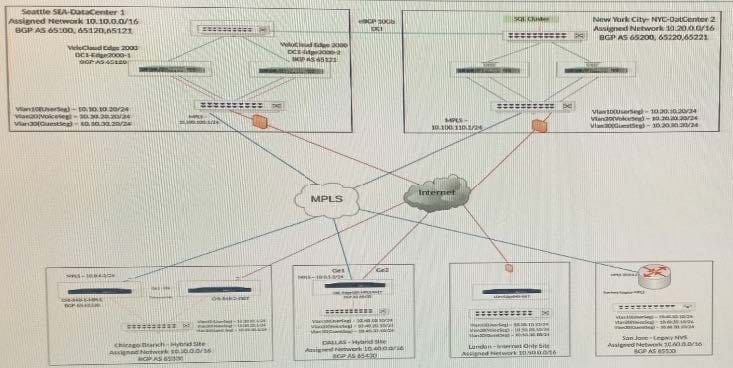
When checking connectivity from the San Jose branch, all users report that they can reach certain resources at the main data center. They are unable to reach locations elsewhere. The network administrator investigates and first looks at the Overlay Flow Control (OFC) Table.
What should the network administrator look for next to determine what the issue might be?
A. Check with the local network administrator to see if the routes for the SD-WAN sites are present in San Jose's branch router.
B. Check Test and Troubleshoot and review a route table dump of the NY hub site.
C. Check the Global Segment Configuration to see if it has the Routing Flag enabled.
D. Determine if OSPF has been configured on the MPLS Routers at the hub.
Questions 10
Scenario 3:
After resolving numerous connectivity Issues throughout the various branch sites, connectivity between applications and users is finally present. The network administrator is informed that during certain tests, applications are not performing as they are expected to. Users report that call quality has not fully improved and that some of their calls either drop or have poor voice quality where the conversation is breaking up. Other users are noticing that file transfers are slower than expect. A group of users from a few sites have reported slowness in accessing internal and external applications.
Exhibit.
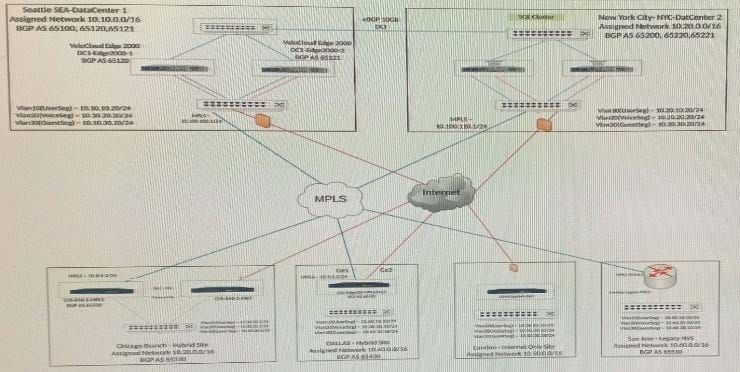
The network administrator has been made aware that Chicago is receiving traffic from non- SD-WAN sites, bottlenecking Chicago's interfaces. The network administrator's VMware SE has mentioned using the uplink feature to help resolve this.
What are two ways the uplink feature should be used in this scenario? (Choose two.)
A. Set the uplink community to forward traffic to a group of neighbors.
B. Direct all traffic to that neighbor designated as an uplink,
C. Stop mutual redistribution of routes from underlay and overlay.
D. Prevent the site in question from becoming a transit site.
Questions 11
Scenario 3:
After resolving numerous connectivity Issues throughout the various branch sites, connectivity between applications and users is finally present- The network administrator is informed (hat during certain tests, applications are not performing as they are expected to. Users report that call quality has not fully improved and that some of their calls either drop or have poor voice quality where the conversation is breaking up. Other users are noticing that file transfers are slower than expect. A group of users from a few sites have reported slowness in accessing internal and external applications.
Exhibit.
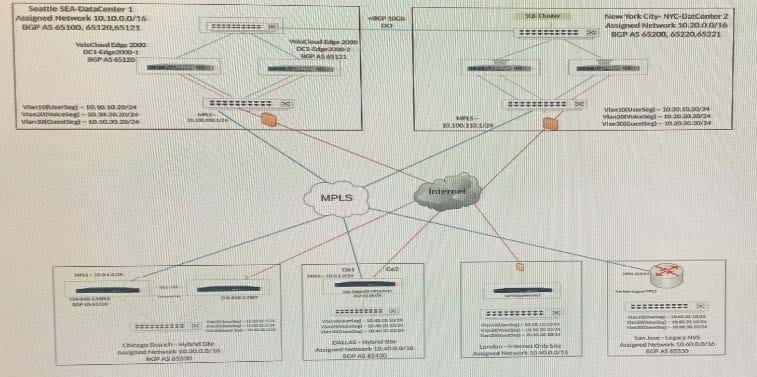
Which metrics can a network administrator verify in the QoE screen to determine the overall health of Underlay and Overlay?
A. Jitter Packet Loss, Speed.
B. Jitter, Packet Loss, Latency.
C. Jitter, Speed, Latency.
D. Packet Loss, Latency, Speed.
Questions 12
Scenario 2:
After completing the branch activation activities for all required branches, the network administrator attempts to test connectivity between the various branches and between the hubs and branches. The administrator notices a lack of connectivity despite being certain that configurations have been complete. The administrator also observed that several users are reporting intermittent connectivity to some of the applications they are accessing. Other users are reporting no access to these applications. Other users at some of the branches claim they cannot get to certain public resources. The administrator wants to ensure that all sites can talk to each other and all resources are accessible.
Exhibit.
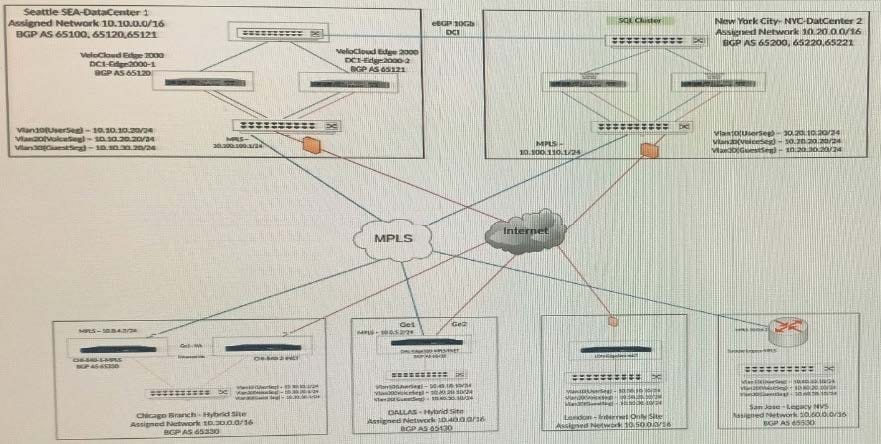
One branch location is not able to communicate with another branch location via dynamic branch-tobranch tunnels. While troubleshooting at the Edge configuration level, the network administrator notices Cloud VPN is not enabled and is grayed out, preventing them from enabling that feature.
A. Where is the next location to check for and enable the necessary feature?
B. Within the Configuration section under Profiles. Within the Monitor section under Network Services.
C. Within the Test and Troubleshooting section under Remote Diagnostics.
D. Within the Configuration section under Customer VPN enablement.
Questions 13
Scenario 2:
After completing the branch activation activities for all required branches, the network administrator attempts to test connectivity between the various branches and between the hubs and branches. The administrator notices a lack of connectivity despite being certain that configurations have been complete. The administrator also observed that several users are reporting intermittent connectivity to some of the applications they are accessing. Other users are reporting no access to these applications. Other users at some of the branches claim they cannot get to certain public resources. The administrator wants to ensure that all sites can talk to each other and all resources are accessible.
Exhibit.
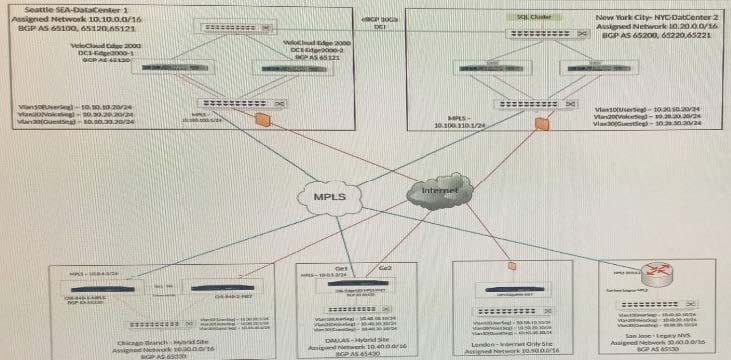
Where can the network administrator check to see what routes are present on the London- site Edge?
A. Log into the VCO > Configuration > Overlay Flow Control
B. Log into the VCO > Test and Troubleshoot > Remote Diagnostics > Run "List Paths"
C. Log into the VCO > Test and Troubleshoot > Remote Diagnostics > Run "Route Table Dump"
D. Log into the VCO > Monitoring > Overlay Flow Control
